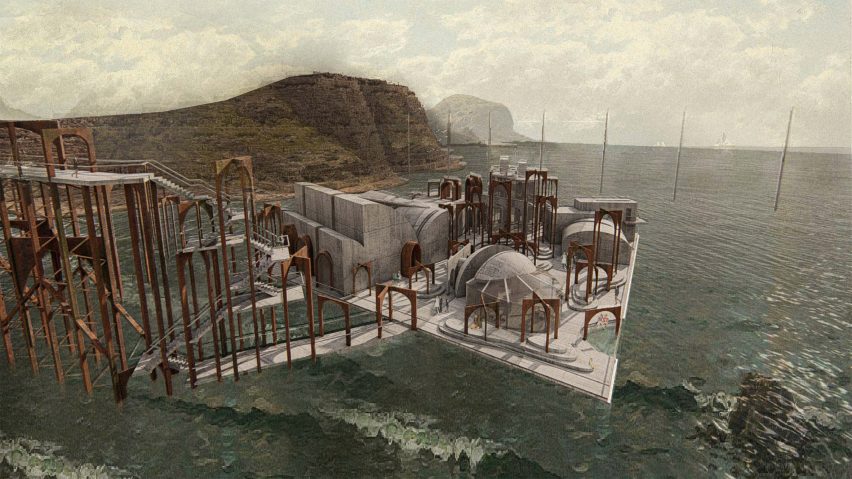
University of Sydney presents 10 architecture and design projects
A digital platform designed to support victims of abuse and an app that aims to help older people socialise online more easily are included in Dezeen's latest school show from students at the University of Sydney.
Also featured is a project that imagines an architectural response to the 2011 Japan earthquake and tsunami, and a library designed to reference Despina, a city from Italo Calvino's book Invisible Cities.
University of Sydney
School: University of Sydney, School of Architecture, Design and Planning
Courses: Master of Architecture, Bachelor of Design in Architecture, Bachelor of Architecture and Environments, Master of Interaction Design and Electronic Arts, Master of Design, Bachelor of Design Computing, Master of Urban Design, Master of Urbanism, Master of Urban and Regional Planning
School statement:
"Ranked first in Australia for Architecture/Built Environment in the QS World University Rankings 2021, the Sydney School of Architecture, Design, and Planning sits proudly on Gadigal land.
"For a School dedicated to the study of place, space and their relationships with people, it is fitting that the traditions of knowledge sharing and community feature intrinsically in the life of the School.
"The School is committed to a sustainable future for Sydney and the world, emphasising and celebrating creativity in our ideas, actions, and interactions.
"With foundational expertise across the humanities, sciences, and social sciences, students are nurtured to be experimental, imaginative, critical, and engaged.
"The School's distinctly Australian identity is informed by global perspectives and a growing awareness of Indigenous knowledge systems, underpinned by a commitment to social justice and equity.
"Odyssey, the School's 2021 Graduate Show, celebrates the exceptional work of our graduating students in architecture, design, and urban planning.
"Catch the exhibition at home or in person with our website, followed by the physical exhibition in Sydney from 31 January 2022."
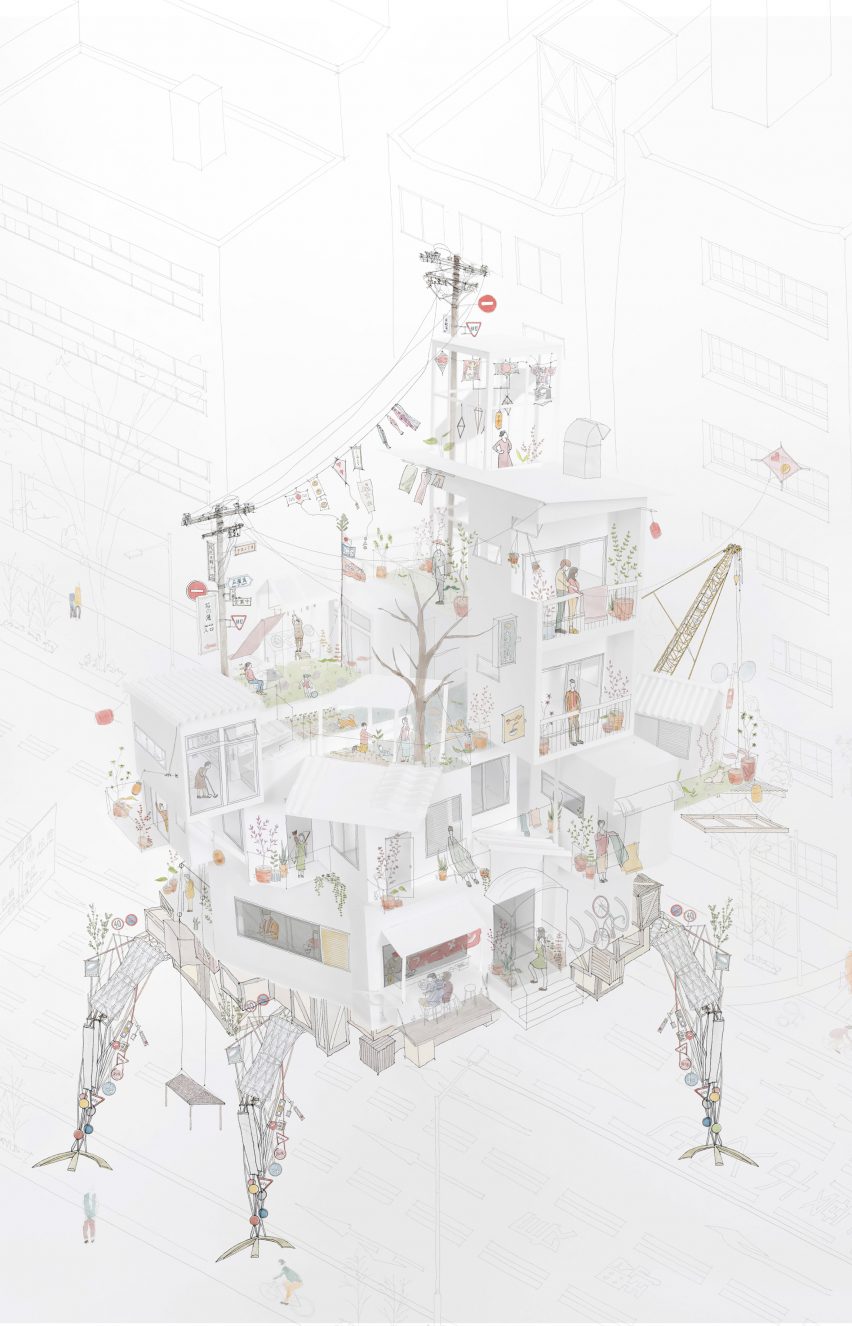
Finding Home, with the Tōkohu Manor by Serena Bomze and Alex Zeng
"This project investigates the rebuilding of identities and moments of the people affected by the 2011 Japan earthquake and tsunami.
"The culminating architectural response imagines an animated and dynamic dwelling that traverses the coasts of the Japanese landscape.
"This assists the displaced in order to physically, spatially, culturally, and emotionally rebuild and rekindle their lost 'webs' of spatial memories and qualities that uniquely define their home.
"The project culminates in the physical form of a highly unique dwelling – its architecture takes on specific elements from each town it passes through, shrinking and growing along the journey.
"It is tailored to its people, both spatially temporal and permanent, and is inspired by Japanese cultural customs and living. The dwelling seeks to give hope, and ultimately, towards refinding home."
Student: Serena Bomze and Alex Zeng
Course: Master of Architecture
Tutor: Sebastian Tsang
Email: sbomze97[at]gmail.com and alex.zeng.arch[at]gmail.com
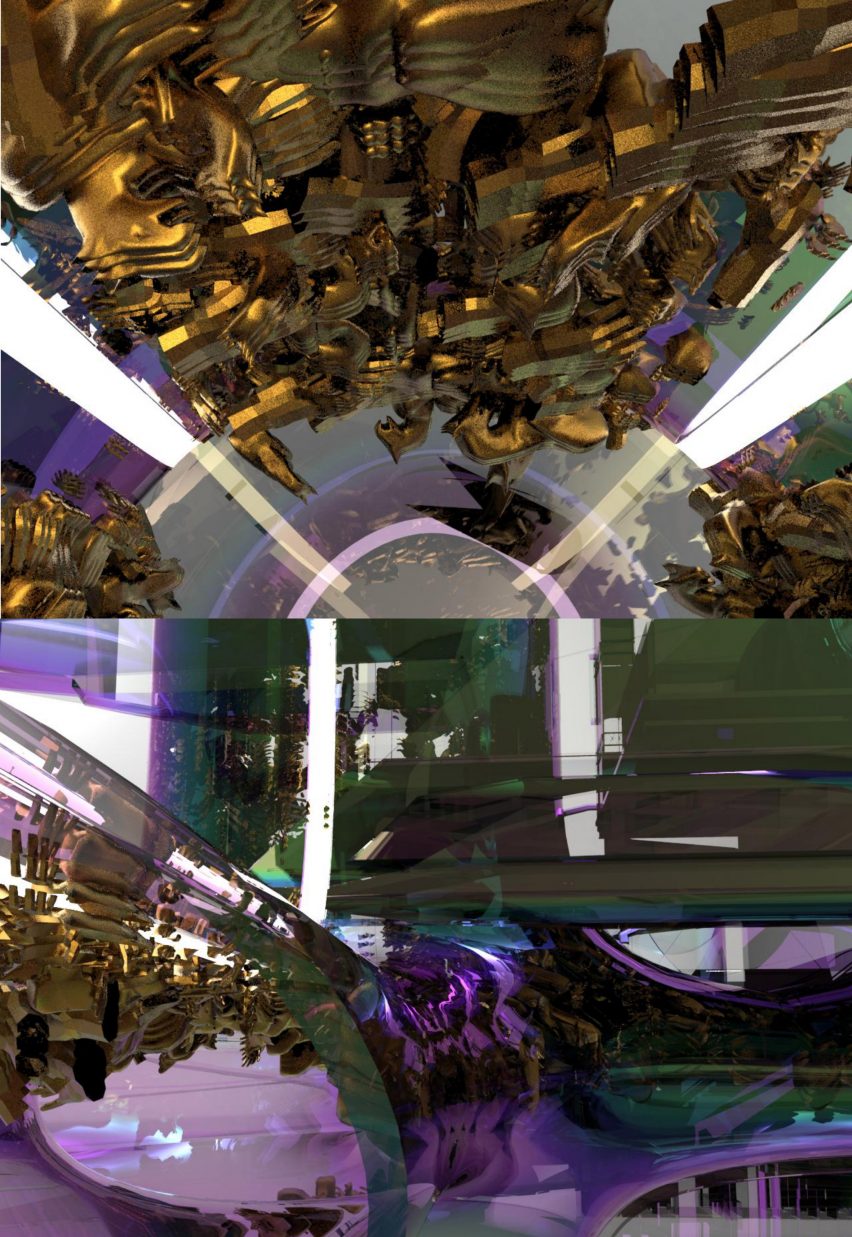
The Flux by Anirudha Agara
"The Flux is a 2050 proposal for the Theatre-Museum of Atmospheric Art as an extension of the Art Gallery of New South Wales, Sydney. The museum oscillates between reality and illusion, leaving the audience to distinguish between fact and fiction.
"The project uses new design techniques and methodologies as vehicles for the discovery of new ways of integrating theory and technology.
"It tries to address fundamental questions of how we perceive art and objects. Inspirations are drawn from works of Archigram, Superstudio and tied with the theory of Object-Oriented Ontology.
"As a process, machine learning (GANs) are deployed to generate unique textures, tectonics, and imagery; based on a dataset containing hundreds of aboriginal artworks cross-pollinated with modern forms of art.
"While the project extensively uses pragmatic technology and approaches, it still eludes conventions and provokes speculative desires."
Student: Anirudha Agara
Course: Master of Architecture
Tutor: Simon Weir and Mano Ponnambalam
Email: aniruddh.agara[at]gmail.com
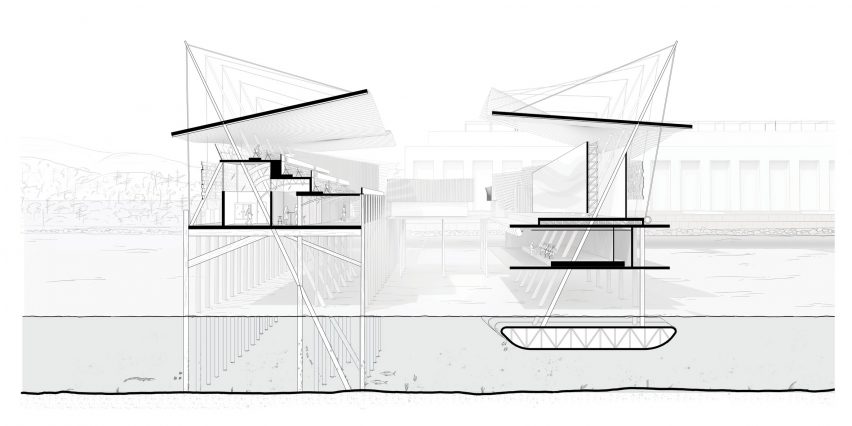
The Spectral Theatre by Chris Hamblin
"The Spectral Theatre at the Coal Loader, Sydney, is an adaptable, semi-outdoor space, emphasising innovative staging in contemporary performance.
"By demolishing the existing dilapidated wharf and restoring that which can be salvaged, the venue will draw attention to the site's past and embedded history from both pre and post-contact, while also providing a space for renewed, restored, and reclaimed ideas.
"The theatre takes its name from a hypothesis that within the layers of our history lie the ghosts of our past.
"By manipulating the proscenium and emphasising technology and staging techniques, the Spectral Theatre aims to pull apart those layers of history. It intends to find stories not tethered by traditional techniques or well-trodden narratives.
"An expanded space where ghosts of the past are observed but ultimately move on, allowing room for new inspiration and tales to be told."
Student: Chris Hamblin
Course: Bachelor of Design in Architecture
Tutor: Christian Williams
Email: chrisjhamblin[at]gmail.com
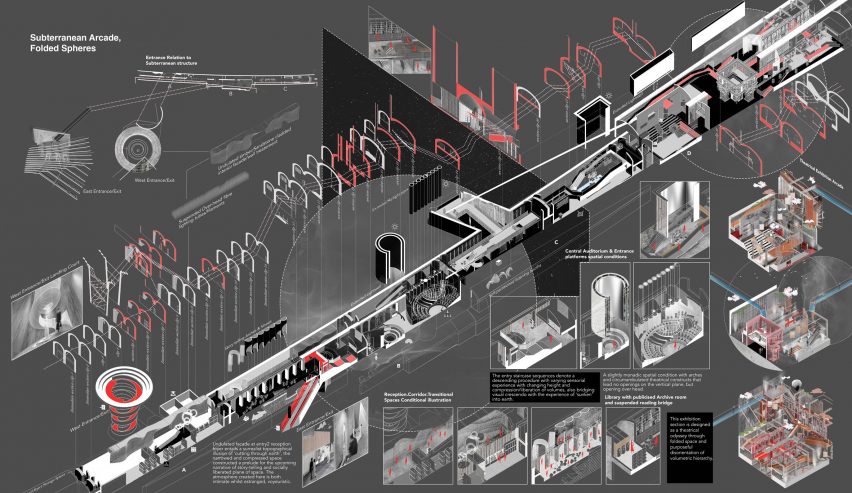
Monument Valley – A Dystopian Escape by Delos He
"The clock has been rewound 95 years at St James Station. Deep under the Archibald Fountain of Sydney's Hyde Park lies a secretive war-time treasure – a converging twin-tunnel running over 200 metres that once served as air-raid shelters and planned city railway additions that never came to fruition.
"The concept deals with the question of permanence, by a sequence of architectural moments conceived as non-enduring relics scattered underneath the ever-changing city, orchestrating a space as theatrical as a behind-the-curtain performance on the urban stage.
"The design reawakens the sleeping ruins with radical and theatricalised architectural interventions, centred on the thematic brief of an Oral History Library. Blurred-boundary program spaces are defined by industrious structures, raw finishes and intersecting planes.
"Alternating threshold moments are inserted to enact story-telling journeys between observers and performers, listeners and presenters, artefacts and minds, monadic and plural, lights and shadows.
"These interactive gestures open up the tunnel beyond its innate exclusivity, rather, reconciling its position with the public realm."
Student: Delos He
Course: Bachelor of Architecture and Environments
Tutor: Mano Ponnambalam
Email: dihe8423[at]uni.sydney.edu.au
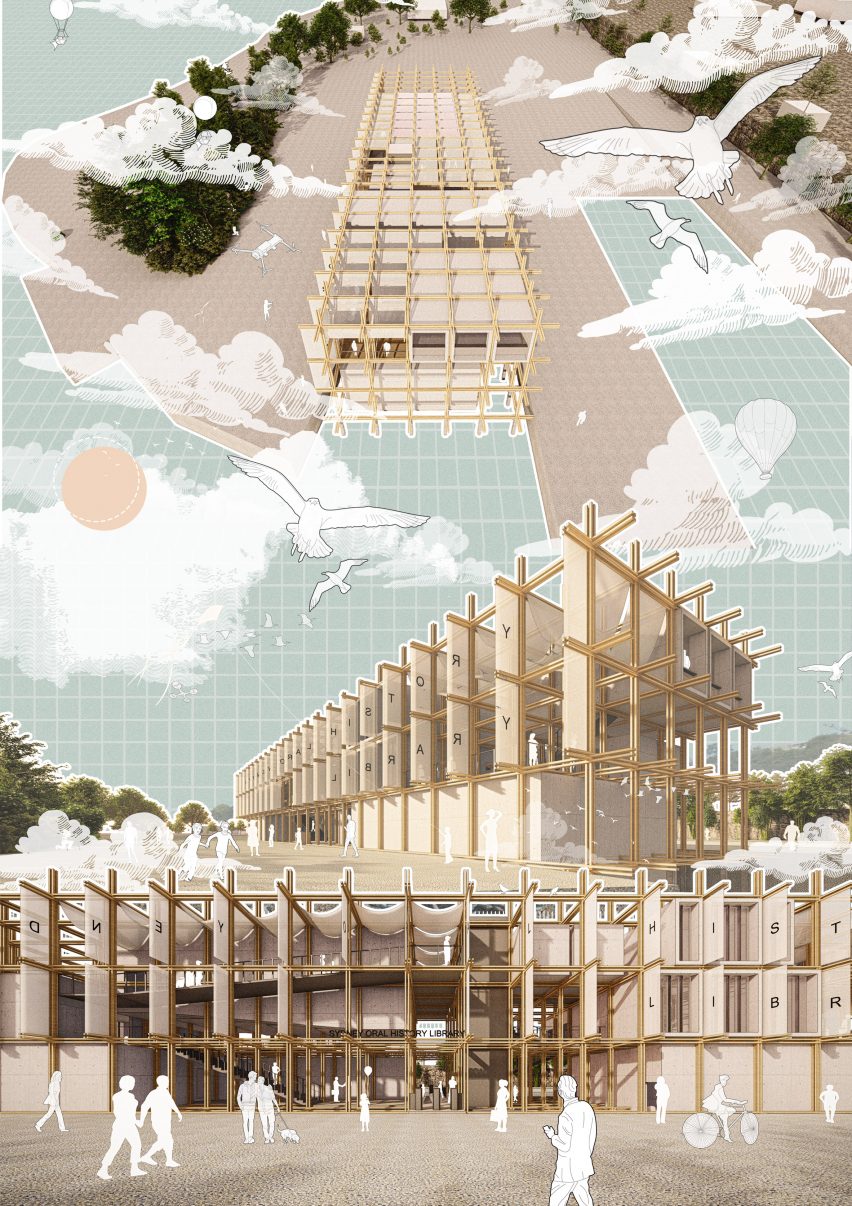
Sydney Oral History Library by Russell Li
"Sydney Oral History Library's design is inspired by the city Despina from Italo Calvino's book, Invisible Cities.
"It is a city between the ocean and desert, with Calvino describing the city as being perceived as a ship when approaching from the desert, and a camel when approaching from the sea.
"This project aims to create a bridge between the land and water as a metaphor of oral history – the bridge between past and present. The site is Sydney's Cockatoo Island, a slipway between land and water.
"The building consists of a timber frame structure and a series of opening precast concrete boxes sitting within the frame.
"The boxes transit from front to the rear, above to below as visitors get closer to the water, engaging the visitors with a series of rotated vessels with a haptic emphasis of light."
Student: Russell Li
Course: Bachelor of Architecture and Environments
Tutor: Matthew Mindrup
Email: russ1946722282[at]gmail.com
MyConnect: Making Australian Healthcare More Accessible by Hugo Dowd, Erin Topfer and Zihe (Zoe) Lu
"We were tasked to create a digital product that enabled Australian citizens to access day-to-day healthcare during a pandemic/lockdown. We were recommended to consider systems that could be adapted and used even after pandemic life.
"MyHealth is an existing $2 billion investment in Telehealth. MyHealth Records is an online summary of a person's key health information. It's accessible by any Australian medical practitioner and allied health services.
"We propose developing the MyConnect app to allow users to upload remote data to their MyHealth Record. Their doctor can access this data through their MyHealth portal.
"The app has many benefits. These include establishing reliable communication between doctors and patients, improving diagnostics and patient monitoring, facilitating better healthcare for remote patients, generating usable patient data to fill MyHealth Records, and helping patients to take control of their health."
Student: Hugo Dowd, Erin Topfer and Zihe (Zoe) Lu
Course: Master of Interaction Design and Electronic Arts
Tutor: Abhiruchi Chhikara
Email: hugo.dowd10[at]gmail.com, topfererin[at]gmail.com and zihelu[at]gmail.com
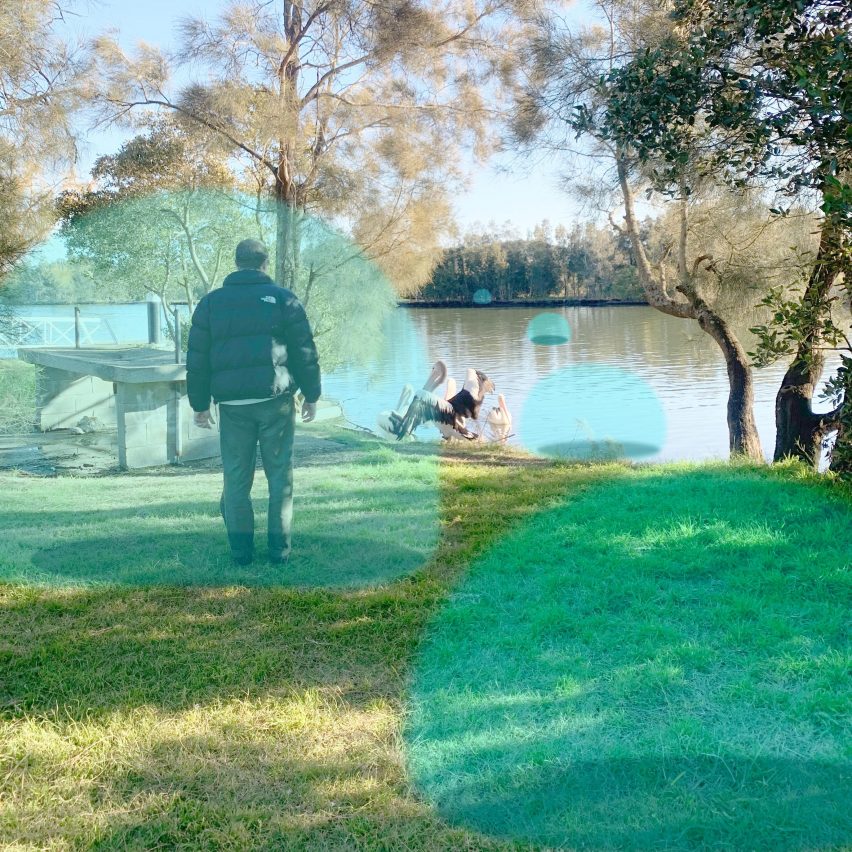
Towards Country-Centred Interaction Design: A Case Study on Audio Augmented Reality on Awabakal Country by Siena White
"Awareness about the destructive effects of colonisation on sustainable pre-colonial ways of living that thrived for millennia has gained increasing momentum in recent years.
"That has led to growing movements in the industry and academia towards understanding Indigenous ways of relating to the country and raises questions about culturally and environmentally appropriate approaches to design.
"This research project, motivated by the challenge of designing an audio augmented reality storytelling application for and with the Awabakal people of New South Wales, Australia, proposes an innovative approach which identifies and consolidates design methods, principles and precepts, mapped to a sustainable design process timeline."
Student: Siena White
Course: Master of Interaction Design and Electronic Arts
Tutor: Luke Hespanhol
Email: sienawhite[at]gmail.com
Confidante by Claire Say, Cyrilla Lowas, Monica Tsui, and Wiryawan Onggo
"Domestic and family violence is one of the most under-reported crimes around the world for reasons such as fear of leaving and psychological abuse.
"The issue has become even more complex and severe as the impact of Covid-19 and social isolation exacerbates acts of violence when victims are restricted to their homes.
"To help victims of domestic violence who have left an abusive relationship, we have created a digital platform designed to support their recovery journey in regaining their independence emotionally, socially, and financially.
"Confidante is a one-stop-shop that provides victim-survivors with a safe online community as well as resources for professional services, job opportunities, and accommodation.
"Our current prototype is the result of constant iteration and refinement. We have tested our concept, security measures and usability with victim-survivors and experts in the DV sector who have praised Confidante for its viability time and time again."
Student: Claire Say, Cyrilla Lowas, Monica Tsui and Wiryawan Onggo
Course: Bachelor of Design Computing
Tutor: Emily Hatton
Email: clairesay13[at]gmail.com, cyrilla.lws[at]gmail.com, monicatsui1[at]gmail.com and wiryawaneo[at]gmail.com
Social Bunch by Margaux Thwaites, Bianca Laycock, Katia Moors and Gabrielle Hong
"While younger generations may find it easy to adapt to the world of social isolation, some older people may find online socialisation more difficult.
"Due to the pandemic, many social and community groups that are important to their wellbeing have been interrupted. How can we move these activities online in a non-intimidating way for people who aren't as accustomed to interacting online?
"Social Bunch alleviates the complexity of traditional social media by creating a space for groups to interact on their own terms, by combining tricky apps and sites like group message boards, video calling, and group scheduling, into one easy-to-access platform.
"We have considered the needs and wants of older adults, building an accessible and approachable app that provides a space for group activities.
"This is all without bombarding the user with options and fancy features, drawing inspiration from familiar technologies to ease the learning curve."
Student: Margaux Thwaites, Bianca Laycock, Katia Moors and Gabrielle Hong
Course: Bachelor of Design Computing
Tutor: Phillip Gough
Email: thwaitesmargaux[at]gmail.com, kmoors47[at]gmail.com, biancalaycock017[at]gmail.com and gabrielle.hong2[at]gmail.com

Behind the Masks by Greta He
"Theatre is a projection of the stories of life. Audiences and performers gather to experience the life stories of characters. What if the play they witness is actually about the story of their own lives?
"Engaging with self-referentiality, this project is an apparatus that dissolves the illusionary boundaries between real-world and theatre and between audiences and characters.
"Thalia and Melpomene, the masks of theatre, draw the connection between the theatre and the real-life – the theatre and life are both never-ending oscillations between comedy and tragedy, and the project intends to articulate the nothingness behind the unending masks.
"The project concretise the intangible Absurdity in life, enabling the audiences to explore the multilayered logic in architecture. It intends to break the repetition of everydayness, questioning the meaning of life.
"The project is designed for the absurd theatre – Waiting for Godot, informed by overlayed stories on the thread of existentialism, that is, The Crystal World, The Myths of Sisyphus and Wanderer Above the Sea of Fog."
Student: Greta He
Course: Bachelor of Design in Architecture
Tutor: Thomas Stromberg
Email: jihe0798[at]uni.sydney.edu.au
Partnership content
This school show is a partnership between Dezeen and the University of Sydney. Find out more about Dezeen partnership content here.